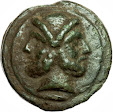Compare the British Museum description to the ones I bought.
Dec
2016 purchase - see pictures directly above
AE Ramo Secco.
Central Italy, Aemilia (?), late 6th to 4th century BC. Vecchi ICC, 3.2. TV AS
1. Haeberlin pl. 7, 6. AE. g. 893.00 RR. C. mm. 88 x 67 x 32. Very rare. Heavy
dark-green patina with minor earthen-brown highlights. The Ramo Secco cast
ingots are found predominantly in Emilia, hence the attribution to his region.
Always found in fragments, they generally weigh from 500 grams to 2000 grams.
British Museum
'Ramo
secco' bar, c. 6th-4th century BC. The name derives from the design of a 'dry
branch'. Such bars are found principally in northern central Italy. An early
date is suggested by the discovery of one piece in a stratum of an excavation
near Gela in Sicily which has been dated by the pottery finds to the 6th century
BC.
May 2016 - see pictures below
Roman Republican Ramo
Secco Currency Bar (Aes Signatum)
CENTRAL ITALY,
Emilia(?): 6th to 4th century BC
Fragment of a
bronze ingot, on both sides branch with no leaves.
AE. 826 grams; Length
= 62 mm, Width = 77 mm, Height = 36 mm
Thurlow-Vecchi AS1.
Vecchi – 3.1
HNI – pg 45 –
highly ferruginous bars made apparently from 6th century in southern
Etruria, Emilia and occasionally Sicily.
Grueber – lists 2
bars, but not RS
Cr – lists bars,
but not RS
Syd AG – not in
Sydenham
Haberline – pg 10 –
19; plates 4 – 6
Garrucci – Table
VII, IX & X
|
Bar Number
|
1
|
2
|
|
Weight, grams
|
826
|
893
|
|
Length, mm
|
61
|
88
|
|
Width, mm
|
77
|
67
|
|
Thick, mm
|
36
|
32
|











No comments:
Post a Comment